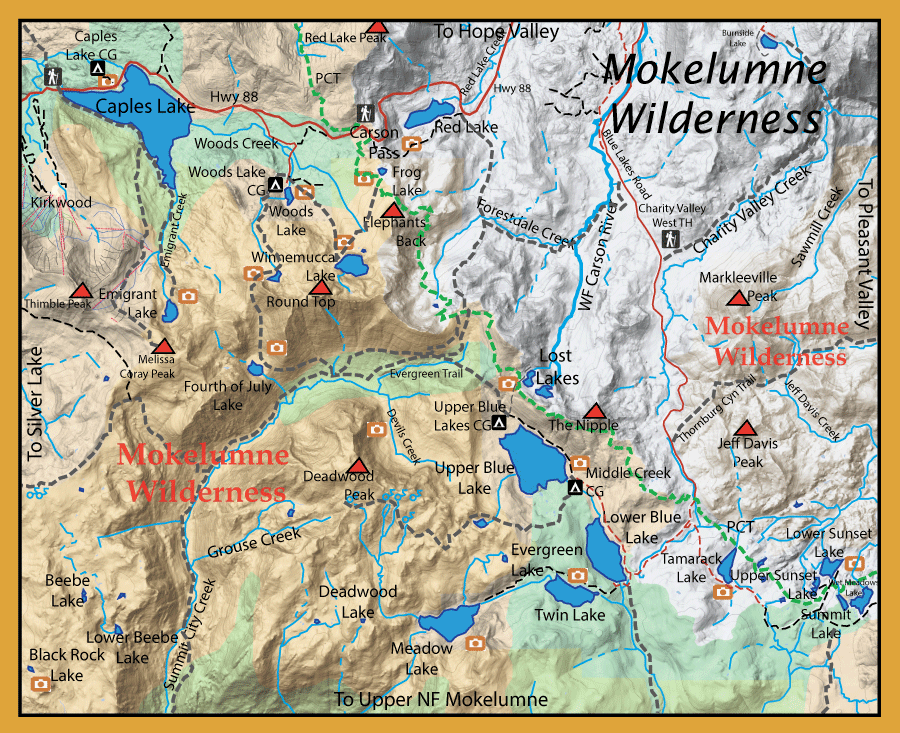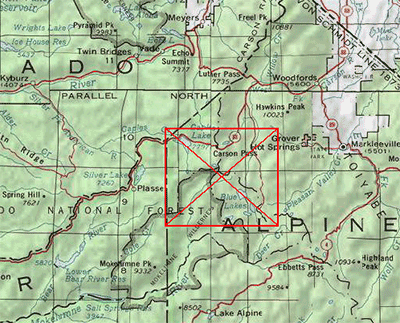

 |
||||
|
Suggested Flies for Mokelumne Wilderness: Sierra Tahoe Hatch Selection |
||||
|
Nymphs: |
Drys: |
Stoneflies: |
Stillwater Streamers: |
|
|
Directions: 
Caples Lake: From Jackson at junction of Highways 49-88, take Highway 88 East and go 50 miles to Silver Lake or 62 miles (past Silver Lake and Kirkwood) to Caples Lake on right. Mokelumne Wilderness: Situated on the crest of the Sierra, spread between three National Forests, the Mokelumne is one of the more accessible wilderness areas in the region. From the north, many visitors enter the wilderness from along Hwy 88 as it crosses Carson Pass. From the east, Markeeville along Hwy 89 is a common point of entry, and from the south Hwy 4 runs along the edge of the Mokelumne as it clears Ebbetts Pass and Bear Valley. | ||
|
| ||
Notes: Caples Lake (ele:7900 feet) is about 600 acres in size. It can be float tubed near the two dams and the inlet at the eastern end of the lake but is primarily fished by boat due to the size and nature of the lake. Often there are winds which can make flyfishing difficult. Ice-out during the late Spring brings the fish into the shallower areas. Best fishing time is early morning or late afternoon. Try streamers such as Olive Woolly Buggers and Matukus with a full-sinking line. Mackinaw Trout inhabit the lake but can only be found deep in the lake by trollers. Contains Rainbows, Brookies, and Browns. Emigrant Lake: (22 acres at 8600' elevation) Four mile hike from Caples Lake with a self-sustaining Brookie population. The lake is fairly shallow with a maximum 27 foot depth. It was planted with Brookies from 1930 to 2000, then reassessed that no further planting were required. Rainbows were also planted within the lake from 1932 to 1947 but could not spawn. Woods Lake: (16 acres at 8000' elevation) Contains both Rainbows and Browns, mostly less than 10 inches in size. Roundtop Lake: (9,341' elevation). Shallow lake mostly with Brookies, less than 10 inches, and some larger Lahontans up to 16 inches. Winnemucca Lake: (8980' elevation). A fairly large lake with some depth on the southern shoreline, up to 70'. Best fished from a float tube but can be fished along shoreline. Wind often picks up in afternoon and the fish seek structure within the deeper water along the eastern shore. Mostly Brookies 8-12 inches but some large Kamploop Rainbows may still exist. Frog Lake: This lake is small but reportedly has some nice large rainbows up to 16 inches. Fourth of July Lake: Consists of small Brookies Red Lake: (85 acres at 8,000' elevation) This lake is owned by the State of Calif. and is managed by CDFW. Best fished during the early season as the lake is drawn down starting in early July. Contains Lahontan Cutthroats and Brookies, 10 to 15 inches. Red Lake Creek: This 4 mile-long creek is small and covered with willows from the outlet at Red Lake to the Hwy 88 bridge, a mile downstream. Proceeding downstream from the bridge, the creek flows through 2.4 miles of public land on it's way to the West Carson River, and this stretch offers your best fishing opportunites. The public stretch is mostly meadowland and provides good dry fly action. Contains mostly Brookies in the 6-8 inch class with some Rainbows. The are some beaver ponds within the upper part of this stretch and the deep pools has some bigger Brookies. The water flows are controlled by CDFW at Red Lake and are maintained for good fish habitat. Parachute Adams and E/C Caddis work well in Spring and Fall. Hoppers are a good but in September. Meadow Lake: (7,774 feet elevation), Contains Brookies and Lahontan Cutts
| ||
Fishing Regulations (Effective March 1st, 2021)All Lakes and Reservoirs: Open all year. No restrictions. 5 trout per day. 10 trout in possession. All creeks and tributaries: From the last Saturday in April through November 15, five trout daily bag limit, 10 trout in possession; and, from November 16 through the Friday preceding the last Saturday in April, 0 trout bag limit, artificial lures with barbless hooks only and trout must be released unharmed and not removed from the water.
| ||
| ||